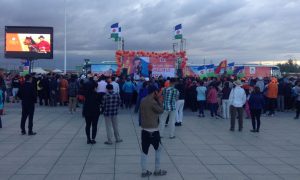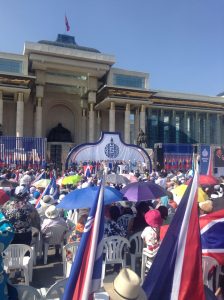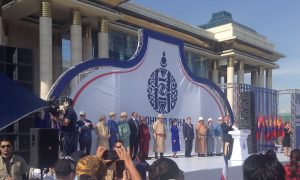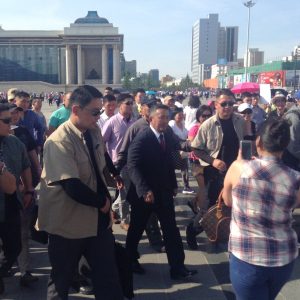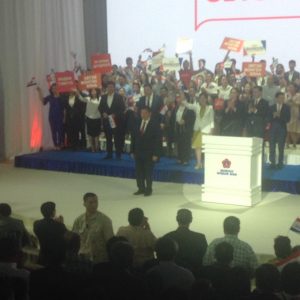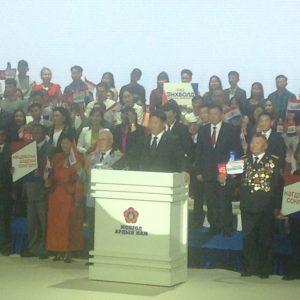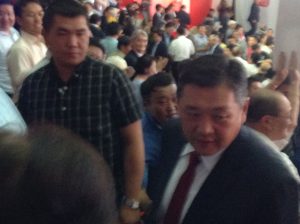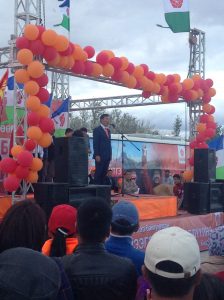By Julian Dierkes
From the perspective of a repeat election observer (this was my fifth national election for which I served as an international observer), the reporting about the election is always somewhat challenging.
On the one hand, I gain so many impressions from election observation that I am keen to share as regular readers of this blog would guess. On the other hand, I feel a real obligation not to draw any conclusions from my personal observations, as they are just that, one person’s observation.
The verdict that the press typically looks for is “free and open” or some variation thereof. In the Mongolian context, I am not sure that that stamp of approval is of any interest to individual voters or even to NGOs, but the international press certainly feeds this label straight into reporting as it provides a nice summary that does not require further fact-checking as a quasi-official statement.
I cannot make such a statement myself, particularly in an election where I was not part of a larger organized election observation mission like the OSCE’s. For the 2017 presidential election, please see the OSCE preliminary report for such a more systematic assessment.
But, I do have a perspective to offer beyond my observations on June 26, namely that this has been my fifth election that I have observed, so I have seen some patters and can compare this year’s election to previous iterations.
Impressions
For a series of photos from the 2017 presidential election, see the Neue Zürcher Zeitung’s Matthias Müller’s photos.
On the whole, I did not see any great differences between the 2013 presidential election and this year’s iteration. As has been noted by all election observation reports, I have always been impressed by a) the care that all the people involved in polling stations take, and b) the technology that is deployed in an effort at electoral transparency and security. Both of those factors were consistent across different polling stations this year as they have been in previous years.
Just for context I should note that for this election I travelled in a long circle from Ulaanbaatar to Zun Mod to Nalaikh and back to Ulaanbaatar. In all these locations, I visited a mix of neighbourhoods from very urban to very rural. In the past as well, I have been in Ulaanbaatar as well as in various aimags across the country, from polling stations that are a stone’s throw (well a powerful throw anyway) away from government house to a polling ger set up especially for an election to comply with the no travel beyond 70km required stipulation, in this case in rural Zavkhan where in the days before the voting machines, the hand-counted results had to be transmitted by riding onto a large hill that had cell phone reception to reach the aimag electoral commission in Uliastay.
This week, I visited 16 polling stations, staying for as long as 30min at some, but as little as 10min at others. Over the five years I would say that I’ve visited a total of 100 polling stations.
This week again, the polling stations operated very smoothly. When challenges arose (lines formed, we saw one malfunctioning voting machine) the electoral commission dealt with these challenges calmly, competently and effectively.
The Layout of Polling Stations
While the physical set-up varies across polling stations, they all diligently provide a private space for voters to fill out their ballot. Tables where voters will out the ballot are deliberately angled away from the view of election officials and observers. When there was no chair in the observers’ corner once and I stood, leaning against the wall, I was quickly asked to sit down on a shared chair, as my height might have allowed me to look onto the desks where voters were filling out their ballots.
At this election for the first time (note that I was in Ulaanbaatar last year for the parliamentary election campaign, but did not stay for election day and did not serve as an observer) I saw seating plans posted at the ballot stations as part of the extensive information about the voting process that is displayed at the stations. These small architectural drawings specify locations of the registration desk, the ballot dispersal station, the voting booths, the voting machines, and the drop-the-folder-and-get-ink-mark station. Actual physical layouts followed these plans very closely. I never saw a voter even glance at the information provided, but it is another piece of evidence of the care that is taken with planning and execution of the election
Another innovation this year were the arrows that pointed voters along the chain of stations as they progressed through the polling station. In most stations, voters are guided through the sequence in a clockwise direction, following general Mongolian practice around ovoos, etc. The arrows did not seem to be very effective as few voters noticed them.
Depending of the number of voters in a riding, there are one, two, or three machines to collect the ballots.
Technology
The technology that is deployed at polling stations continues to be impressive.
Filming inside of polling station for broadcast to outside
At all polling stations, there is a large TV placed outside of the actual voting place that shows a video image of the inside. Any interested voter individual could observe the entire proceedings all day long should they care to.
Voter demographics
As voters are checked in via their fingerprint, their photo appears on a large screen in the polling station, allowing observers (mostly party observers) to confirm their identity.
The same screen also offers tabulations of voting.
This includes the same of female/male voters, a breakdown of voters by age cohorts, a breakdown of votes recorded by those collect through mobile voting, those added to a local registration, and those voting as registered.
The turnout is also presented as a number as well as a bar graph.
Obviously, an empirical social scientist’s dream.
Given the data that is produced here for the information of local citizens, I completely agree with the preliminary report of the observation missions, that “transparency was somewhat limited by the GEC releasing only aggregated results”.
If citizens and perhaps especially the local citizens and party observers could access the polling-station-by-polling station information, they would be able to compare these to their own observations further increasing trust in the election procedures. Visiting social scientists would also be thrilled. For example, during my day of observation, I noticed that in virtually all polling stations female voters outnumbered male voters, generally in a ration of about 58:42. Was this a local/regional phenomenon? What does it mean?
Fingerprinting, Laptops, Machinery
There are usually at least four laptops around the polling stations. Two operated by election officials from the citizens’ registry (sorry, forget the exact name of the agency) that are connected to the fingerprint-reader.
We saw a few incidences of the fingerprint-reader having a hard time with someone’s fingerprint, perhaps because of wrinkles, very darkly tanned skin, or skin disease. In those cases, voters were allowed to vote by being entered by their national id number.
Challenges
I have seen some challenges in the voting process, a number of them recurring. I list these here not to criticize the procedures as they were not impacted severely by these challenges, but perhaps as suggestions.
Folder
The folder that voters use to carry the ballot to the voting machine does not work well. It is simple enough, i.e. an open folder of almost equal size to the ballot. It was folder over at the top to prevent voters from trying to feed the folder into the voting machine with the ballot. We actually observed this twice, i.e. voters trying to feed the folder into the voting machine, so the fold seems to fulfill an important role. Yet, the folder system is awkward.
Voting Machine
In its design, the slot where the ballot is fed in resembles a fax machine. Those readers of a younger generation are encouraged to search for “facsimile machine” online and I trust that some virtual museum will offer a display. The design is easy enough, i.e. a slot that the ballot is fed into, just like we used to feed sheets of paper into a fax machine. But the problems seems to be that the vast majority of voters have never used a fax machine. Perhaps this design could be improved upon.
Also (as always happened with fax machines, and still happens with copy machines) it is very unclear how to insert the ballot, upside down, right side up? It turns out that it does not matter, but voters do not realize that and election commission members are often asked to help. That seems to be a somewhat systemic weakness, though it also speaks to the humanity and pragmatism of the election commissions.
The greatest menace to the voting machine are toddlers and babies. Mongolia being a very child-friendly society in public, obviously sees many parents of young children brining their kids along to vote. Well, kids like to push buttons and pull on things. The voting machines do not always take well to these expressions of affection and some officials get quite nervous when children are circling the voting machine.
Conclusion
I have nothing to say about the election in general, having only seen a very specific subsection of polling stations. However, the election operated smoothly at these stations (as it had at the very many stations I have visited previously since 2008), and the operations inside the ballot station do not give rise to any suspicions of fraud at all. Instead, in technical terms, it seems to me that the enormous effort put unto planning and execution of the election pays of handsomely in terns of the organizational success that it represents.

 Follow
Follow